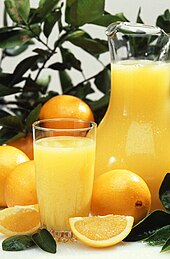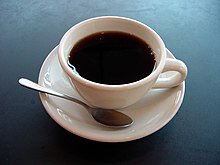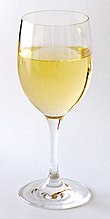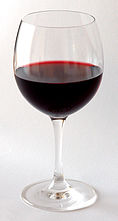Drink

A drink or beverage is a
In addition,
Biology
When the human body becomes
As
History
Drinking has been a large part of socialising throughout the centuries. In Ancient Greece, a social gathering for the purpose of drinking was known as a symposium, where watered down wine would be drunk. The purpose of these gatherings could be anything from serious discussions to direct indulgence. In Ancient Rome, a similar concept of a convivium took place regularly.
Many early societies considered alcohol a gift from the gods,[13] leading to the creation of gods such as Dionysus. Other religions forbid, discourage, or restrict the drinking of alcoholic drinks for various reasons. In some regions with a dominant religion the production, sale, and consumption of alcoholic drinks is forbidden to everybody, regardless of religion.
Toasting is a method of honouring a person or wishing good will by taking a drink.[13] Another tradition is that of the loving cup, at weddings or other celebrations such as sports victories a group will share a drink in a large receptacle, shared by everyone until empty.[13]
In East Africa and Yemen, coffee was used in native religious ceremonies. As these ceremonies conflicted with the beliefs of the Christian church, the
Production
A drink is a form of liquid which has been prepared for human consumption. The preparation can include a number of different steps, some prior to transport, others immediately prior to consumption.
Purification of water
Water is the chief constituent in all drinks, and the primary ingredient in most. Water is purified prior to drinking. Methods for purification include filtration and the addition of chemicals, such as chlorination. The importance of purified water is highlighted by the World Health Organization, who point out 94% of deaths from diarrhea – the third biggest cause of infectious death worldwide at 1.8 million annually – could be prevented by improving the quality of the victim's environment, particularly safe water.[16]
Pasteurisation
Juicing
The process of extracting
Infusion
Percolation
The name is derived from the word "percolate" which means to cause (a solvent) to pass through a permeable substance especially for extracting a soluble constituent.[18] In the case of coffee-brewing the solvent is water, the permeable substance is the coffee grounds, and the soluble constituents are the chemical compounds that give coffee its color, taste, aroma, and stimulating properties.
Carbonation
Carbonation is the process of dissolving carbon dioxide into a liquid, such as water.
Fermentation
Fermentation is a
When
Distillation
Distillation is a method of
Mixing
An
Type
Non-alcoholic drinks

A
Water
Water is the world's most consumed drink,[26] however, 97% of water on Earth is non-drinkable salt water.[27] Fresh water is found in rivers, lakes, wetlands, groundwater, and frozen glaciers.[28] Less than 1% of the Earth's fresh water supplies are accessible through surface water and underground sources which are cost effective to retrieve.[29]
In western cultures, water is often drunk cold. In the Chinese culture, it is typically drunk hot.[30]
Milk
Carbonated drinks
Carbonated drinks refer to drinks which have carbon dioxide dissolved into them. This can happen naturally through fermenting and in natural water spas or artificially by the dissolution of carbon dioxide under pressure. The first commercially available artificially carbonated drink is believed to have been produced by Thomas Henry in the late 1770s.[32] Cola, orange, various roots, ginger, and lemon/lime are commonly used to create non-alcoholic carbonated drinks; sugars and preservatives may be added later.[33]
The most consumed carbonated soft drinks are produced by three major global brands: Coca-Cola, PepsiCo and the Dr Pepper Snapple Group.[34]
Juice and plant drinks

Fruit juice is a natural product that contains few or no additives. Citrus products such as orange juice and tangerine juice are familiar breakfast drinks, while grapefruit juice, pineapple, apple, grape, lime, and lemon juice are also common. Coconut water is a highly nutritious and refreshing juice. Many kinds of berries are crushed; their juices are mixed with water and sometimes sweetened. Raspberry, blackberry and currants are popular juices drinks but the percentage of water also determines their nutritive value. Grape juice allowed to ferment produces wine.
Fruits are highly perishable so the ability to extract juices and store them was of significant value. Some fruits are highly acidic and mixing them with water and sugars or honey was often necessary to make them palatable. Fruits can also be blended with ice and other ingredients to make a smoothie. Early storage of fruit juices was labor-intensive, requiring the crushing of the fruits and the mixing of the resulting pure juices with sugars before bottling.
Vegetable juices are usually served warm or cold. Different types of vegetables can be used to make vegetable juice such as carrots, tomatoes, cucumbers, celery and many more. Some vegetable juices are mixed with some fruit juice to make the vegetable juice taste better. Many popular vegetable juices, particularly ones with high tomato content, are high in sodium, and therefore consumption of them for health must be carefully considered. Some vegetable juices provide the same health benefits as whole vegetables in terms of reducing risks of cardiovascular disease and cancer.
Plant milk is a general term for any milk-like product that is derived from a plant source. The most common varieties internationally are soy milk, almond milk, rice milk and coconut milk.
| Type of fruit drink [35] | Percentage of fruit needed in drink | Description |
|---|---|---|
| Fruit juice | 100%[36] | Largely regulated throughout the world; 'juice' is often protected to be used for only 100% fruit.[36] |
| Fruit drink | 10%[33][35] | Fruit is liquefied and water added.[35] |
| Fruit squash | 25%[35] | Produced using strained fruit juice, 45% sugar and preservatives.[35] |
| Fruit cordial | 0%[37] | All 'suspended matter' is eliminated by filtration or clarification.[35] and therefore appears clear[33] This type of drink, if described as 'flavoured,' may not have any amount of fruit.[37] |
| Fruit punch | 25%[35] | A mixture of fruit juices. Contains around 65% sugar.[35] |
| Fruit syrups | - | 1 fruit crushed into puree and left to ferment. Is then heated with sugar to create syrup.[33][35] |
| Fruit juice concentrates | 100%[35] | Water removed from fruit juice by heating or freezing.[33] |
| Carbonated fruit drinks | - | Carbon dioxide added to fruit drink.[35] |
| Fruit nectars[38] | 30%[38] | Mixture of fruit pulp, sugar and water which is consumed as 'one shot'.[38] |
| Fruit Sherbets[39] | - | Cooled drink of sweetened diluted fruit juice.[39] |
Sleep drinks
A
Alcoholic drinks
A drink is considered "alcoholic" if it contains ethanol, commonly known as alcohol (although in chemistry the definition of "alcohol" includes many other compounds). Beer has been a part of human civilisation for around 8,000 years.[40]
Beer
Some of humanity's earliest known writings refer to the production and distribution of beer: the
Cider
Wine
Wines made from produce besides grapes are usually named after the product from which they are produced (for example,
Wine has a rich history dating back thousands of years, with the earliest production so far discovered having occurred c. 6000 BC in Georgia.[4][56][5] It had reached the Balkans by c. 4500 BC and was consumed and celebrated in ancient Greece and Rome.
From its earliest appearance in written records, wine has also played an important role in religion.
Spirits
Spirits are
Hot drinks
These drinks are often served warm or hot.
Coffee

Coffee is slightly
Coffee cultivation first took place in southern
Coffee may have been used socially in the renaissance period of the 17th century.[62] The increasing trades between Europe and North Africa regions made coffee more widely available to Europeans gathering at social locations that served coffee, possibly contributing to the growth of coffeehouses.[62]
Hot chocolate
Hot chocolate, also known as drinking chocolate or cocoa, is a heated drink consisting of shaved chocolate, melted chocolate or cocoa powder, heated milk or water, and usually a sweetener. Hot chocolate may be topped with whipped cream. Hot chocolate made with melted chocolate is sometimes called drinking chocolate, characterized by less sweetness and a thicker consistency.[63]
The first chocolate drink is believed to have been created by the
Hot chocolate is consumed throughout the world and comes in multiple variations, including the spiced chocolate para mesa of Latin America, the very thick cioccolata calda served in Italy and chocolate a la taza served in Spain, and the thinner hot cocoa consumed in the United States. Prepared hot chocolate can be purchased from a range of establishments, including
Tea
Tea, the second most consumed drink in the world, is produced from infusing dried leaves of the Camellia sinensis shrub, in boiling water.


Herbal tea
Around the world, people refer to other herbal infusions as "teas"; it is also argued that these were popular long before the Camellia sinensis shrub was used for tea making.[69] Leaves, flowers, roots or bark can be used to make a herbal infusion and can be bought fresh, dried or powdered.[70]
In culture
Places to drink
Throughout history, people have come together in establishments to socialise whilst drinking. This includes cafés and coffeehouses, focus on providing hot drinks as well as light snacks. Many coffee houses in the Middle East, and in West Asian immigrant districts in the Western world, offer shisha (nargile in Turkish and Greek), flavored tobacco smoked through a hookah. Espresso bars are a type of coffeehouse that specialize in serving espresso and espresso-based drinks.
In China and Japan, the establishment would be a
Alcoholic drinks are served in
In contrast, types of bars range from seedy bars or nightclubs, sometimes termed "dive bars",, or they may sit at tables and be served by cocktail servers.
Matching with food
Food and drink are often paired together to enhance the taste experience. This primarily happens with wine and a culture has grown up around the process. Weight, flavors and textures can either be contrasted or complemented.[76] In recent years, food magazines began to suggest particular wines with recipes and restaurants would offer multi-course dinners matched with a specific wine for each course.[77]
Presentation
Different drinks have unique receptacles for their consumption. This is sometimes purely for presentations purposes, such as for cocktails. In other situations, the drinkware has practical application, such as coffee cups which are designed for insulation or brandy snifters which are designed to encourage evaporation but trap the aroma within the glass.
Many glasses include a stem, which allows the drinker to hold the glass without affecting the temperature of the drink. In champagne glasses, the bowl is designed to retain champagne's signature
Commercial trade
International exports and imports
An important export commodity, coffee was the top agricultural export for twelve countries in 2004,[78] and it was the world's seventh-largest legal agricultural export by value in 2005.[79] Green (unroasted) coffee is one of the most traded agricultural commodities in the world.[80]
Investment
Some drinks, such as wine, can be used as an alternative investment.[81] This can be achieved by either purchasing and reselling individual bottles or cases of particular wines, or purchasing shares in an investment wine fund that pools investors' capital.[82]
See also
- List of beverages
- List of hot drinks
- List of national drinks
- List of food and drink monuments
References
- ^ S2CID 20752304.
- ISBN 978-1-134-78879-8.
- ^ Keys, David (2003-12-28). "Now that's what you call a real vintage: professor unearths 8,000-year-old wine". The Independent. Retrieved 2011-03-20.
- ^ a b Berkowitz, Mark (1996). "World's Earliest Wine". Archaeology. 49 (5). Archaeological Institute of America. Retrieved 25 June 2008.
- ^ ISBN 978-0-7614-3033-9.
- ^ Ellsworth, Amy (18 July 2012). "7,000 Year-old Wine Jar".
- ^ [1] Prehistoric brewing: the true story, 22 October 2001, Archaeo News. Retrieved 13 September 2008
- ^ "Dreher Breweries, Beer-history". Archived from the original on 2009-07-09. Retrieved 2010-09-21.
- doi:10.1038/scientificamerican0507-102. Archived from the originalon 16 October 2007. Retrieved 4 November 2007.
- ^ Dornbusch, Horst (27 August 2006). "Beer: The Midwife of Civilization". Assyrian International News Agency. Retrieved 4 November 2007.
- ^ Protz, Roger (2004). "The Complete Guide to World Beer".
When people of the ancient world realised they could make bread and beer from grain, they stopped roaming and settled down to cultivate cereals in recognisable communities.
- ^ Mary Lou Heiss; Robert J. Heiss. The Story of Tea: A Cultural History and Drinking Guide.
- ^ ISBN 978-0-470-07344-5.
- ^ Pankhurst, Richard (1968). Economic History of Ethiopia. Addis Ababa: Haile Selassie I University. p. 198.
- ^ Hopkins, Kate (March 24, 2006). "Food Stories: The Sultan's Coffee Prohibition". Accidental Hedonist. Archived from the original on November 20, 2012. Retrieved January 3, 2010.
- ISBN 978-92-4-159522-3. Archived(PDF) from the original on 2008-05-21.
- PMID 20784713
- ^ "percolate". Merriam Webster. 2008. Retrieved 2008-01-09.
- ISBN 1-58017-105-2
- ISBN 1-891267-91-4
- ISBN 978-1-61608-463-9. Retrieved 13 November 2012.
- ^ Thomas, Jerry (1862). How To Mix Drinks. Dick & Fitzgerald.
- ^ Regan, Gary (2003). The Joy of Mixology. Potter.
- ^ DeGroff, Dale (2002). The Craft of the Cocktail. Potter.
- ^ "Differences between alcoholic and non-alcoholic beers". www.drinkaware.co.uk. Retrieved 19 May 2020.
- ISBN 978-0-233-00212-5.
- ^ "Earth's water distribution". United States Geological Survey. Retrieved 2009-05-13.
- ^ Where is Earth's water? Archived 2013-12-14 at the Wayback Machine, United States Geological Survey.
- ]
- ^ Liu, Nicole (12 March 2016). "China's go-to beverage? Hot water. Really". Los Angeles Times. Retrieved 14 March 2016.
- PMID 17782638.
- ISBN 978-1-4051-7170-0.
- ^ ISBN 978-81-203-2086-4.
- ^ "Soft Drink Industry: Market Research Reports, Statistics and Analysis". Report Linker. Retrieved 10 June 2013.
- ^ ISBN 978-81-224-1481-3.
- ^ ISBN 978-0-8342-1289-3.
- ^ a b Cooper, Derek (1970). The Beverage Report. London: Routledge & Kegan Paul Ltd. p. 55.
- ^ ISBN 978-1-4398-4885-2.
- ^ ISBN 978-1-4200-0161-7.
- ^ Arnold, John P (2005). Origin and History of Beer and Brewing: From Prehistoric Times to the Beginning of Brewing Science and Technology (Reprint ed.). BeerBooks.com.
- ISBN 978-1-118-67497-0.
- ^ "Volume of World Beer Production". European Beer Guide. Archived from the original on 28 October 2006. Retrieved 17 October 2006.
- ^ Shoemaker, Camille (May 2017), Women & the Beverage that Changed the World., National Women's History Museum
- ISBN 978-0-415-31121-2. Retrieved 21 September 2010.
- ISBN 978-0-7141-1736-2. Retrieved 13 January 2012.
- ISBN 978-0-9662084-1-2. Retrieved 13 January 2012.
- ^ Joshua J. Mark (2011). Beer. Ancient History Encyclopedia.
- ISBN 978-1-4027-6694-7. Retrieved 7 August 2010.
- ^ "Beer Before Bread". Alaska Science Forum #1039, Carla Helfferich. Archived from the original on 9 May 2008. Retrieved 13 May 2008.
- ^ "Nin-kasi: Mesopotamian Goddess of Beer". Matrifocus 2006, Johanna Stuckey. Archived from the original on 24 May 2008. Retrieved 13 May 2008.
- ISBN 978-0-19-926311-0.
- ^ Lea, Andrew. "The Science of Cidermaking Part 1 – Introduction". Retrieved 2 November 2011.
- ^ "National Association of Cider Makers". Retrieved 2007-12-21.
- ^ "Interesting Facts". National Association of Cider Makers. Archived from the original on 14 February 2009. Retrieved 24 February 2009.
- ISBN 978-0-671-79182-7.
- ^ Keys, David (28 December 2003). "Now that's what you call a real vintage: professor unearths 8,000-year-old wine". The Independent. Archived from the original on October 5, 2011. Retrieved 20 March 2011.
- doi:10.1038/146262e0.
- ^ Coffee and Health. Thecoffeefaq.com (2005-02-16). Retrieved on 2013-01-22.
- S2CID 27175168.
- ^ Kummer 2003, pp. 160–5
- ^ ISBN 978-0-415-92722-2. Retrieved November 18, 2015.
- ^ a b Outram, Dorinda (1995). The Enlightenment. Cambridge University Press.
- ISBN 978-0-470-12165-8.
- ^ Bee Wilson (15 Sep 2009). "Aztecs and cacao: the bittersweet past of chocolate". Telegraph.
- ^ Trivedi, Bijal (July 17, 2012). "Ancient Chocolate Found in Maya "Teapot"". National Geographic. Archived from the original on July 20, 2002. Retrieved July 15, 2017.
- ISBN 978-0-8048-3724-8.
- ISBN 978-1-86189-892-0.
- ISBN 978-0-387-92271-3.
- ISBN 978-1-4429-6955-1.
- ISBN 978-0-7946-5004-9.
- ^ Public House Britannica.com; Subscription Required. Retrieved 3 July 2008.
- ^ "Scottish pubs". Insiders-scotland-guide.com. Retrieved 4 November 2012.
- ISBN 978-1-873150-53-5. Retrieved 27 March 2011.
- ^ Australian Drinking Culture Archived 2020-11-09 at the Wayback Machine Convict Creations. Retrieved 24 April 2011.
- ISBN 978-0-9703125-8-7. Retrieved 2010-07-22.
- ISBN 0-14-200492-8
- ISBN 1-56305-434-5
- ^ "FAO Statistical Yearbook 2004 Vol. 1/1 Table C.10: Most important imports and exports of agricultural products (in value terms) (2004)" (PDF). FAO Statistics Division. 2006. Archived from the original (PDF) on 2008-06-25. Retrieved September 13, 2007.
- ^ "FAOSTAT Core Trade Data (commodities/years)". FAO Statistics Division. 2007. Archived from the original on October 14, 2007. Retrieved October 24, 2007. To retrieve export values: Select the "commodities/years" tab. Under "subject", select "Export value of primary commodity." Under "country," select "World." Under "commodity," hold down the shift key while selecting all commodities under the "single commodity" category. Select the desired year and click "show data." A list of all commodities and their export values will be displayed.
- (PDF) from the original on 2016-05-08.
- ^ Greenwood, John (2008-10-06). "First class returns for alternative investments".
- ^ "Buying wine for investment". IFWIC.org. Archived from the original on 16 January 2012. Retrieved 16 January 2012.
Bibliography
- Kummer, Corby (August 19, 2003). The Joy of Coffee: The Essential guide to Buying, Brewing, and Enjoying. Boston: ISBN 978-0-618-30240-6.
External links
- Hana LaRock (30 Aug 2019). "8 of the world's most unusual drinks". CNN.
 Beverages at the Wikibooks Cookbook subproject
Beverages at the Wikibooks Cookbook subproject- Health-EU Portal – Alcohol
- Wikibooks Cookbook
- Women and Beer: A Forgotten Pairing (National Women's History Museum)


